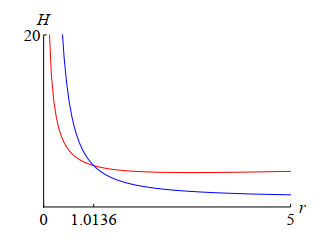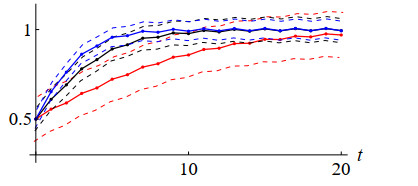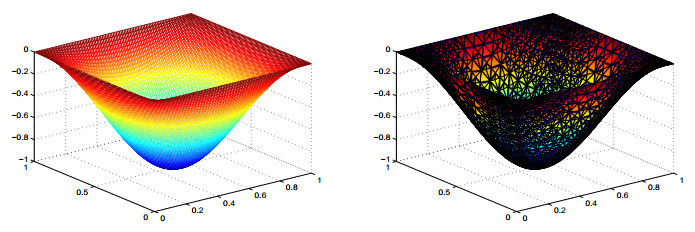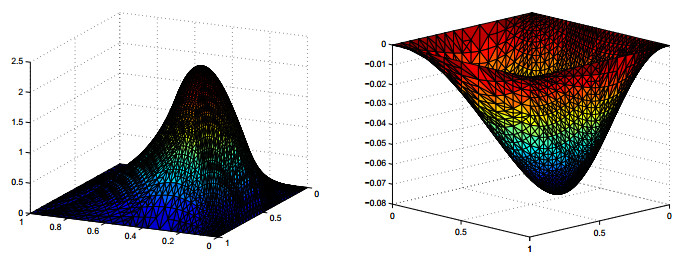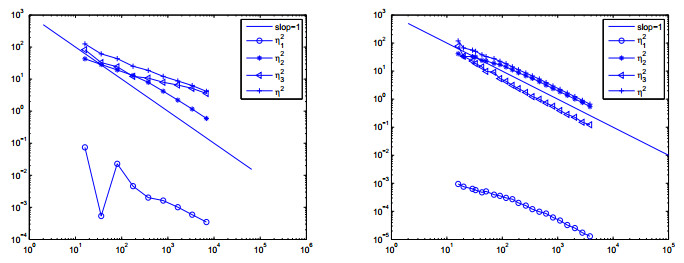1.
Introduction
Hyers–Ulam stability is concerned with ascertaining whether, given a solution of a perturbed equation, a solution to the unperturbed equation exists that remains close to the given solution of the perturbed equation. The recent monographs from Brzdęk et al. [1] and Tripathy [2] provide excellent overviews of the area. Initially, much of the Hyers–Ulam stability analysis for differential and difference equations was concerned with linear equations. For example, Baias et al. [3] investigated the Hyers–Ulam stability of first-order linear difference equations. Similarly, Bora and Shankar [4], Chen and Si [5], and Kerekes et al. [6] explored the Hyers–Ulam stability of second-order linear difference equations. Additionally, Novac et al. [7] and Shen and Li [8] examined the Hyers–Ulam stability of higher order linear difference equations. Furthermore, Buşe et al. [9] analyzed the stability of first-order matrix two-dimensional differential and difference systems. However, there is a growing interest in the analysis of Hyers–Ulam stability for nonlinear equations, which may be conditional stability. It is often the case in nonlinear analysis that the perturbation must be bounded above and the initial condition must be bounded above or below for Hyers–Ulam stability to be possible. Popa et al. [10] explore approximate solutions of the logistic equation and Hyers–Ulam stability, followed by Onitsuka [11,12] investigating conditional Hyers–Ulam stability and its application to the logistic model and approximate solutions of the generalized logistic equation, respectively. Also in the continuous case, Backes et al. establish conditional Lipschitz shadowing for ordinary differential equations in [13]. In the discrete case, Jung and Nam [14] analyze the Hyers–Ulam stability of the Pielou logistic difference equation, while Nam [15,16,17] studies the Hyers–Ulam stability of elliptic, hyperbolic, and loxodromic Möbius difference equations, respectively. Models in population ecology can be continuous or discrete. One of the advantages of the discrete case is modeling seasonal reproduction rather than continuous reproduction. See, for example, [18]. Models in economics can also be continuous or discrete. One can model logistically the relationship between advertising and sales of a product as a series of discrete expenditures, of step-size h, with diminishing impact on sales over time, see for example [19].
Motivated by these works and the relative sparsity of results related to conditional Hyers–Ulam stability and its application to nonlinear difference equations, in this study, we address the logistic growth h-difference equation for step-size h. As h converges to zero, it will be demonstrated that our conditional stability results are consistent with those derived for the continuous case. In contrast, setting h=1 leads to significant advancements over previous research. We successfully identify the optimal lower bound of the initial value and the upper bound of the perturbation amplitude, which are essential for ensuring stability in nonlinear systems. Most importantly, we demonstrate a substantial improvement in the Hyers–Ulam stability constant, a measure of stability, compared to prior work.
This study will proceed as follows. In Section 2, we introduce the discrete logistic equation model, define conditional Hyers–Ulam stability, and derive important inequalities related to solutions of the logistic model and solutions of perturbations on the model. We explain that the perturbations must be bounded above in size, while the initial population size must be bounded away from zero for stability to occur. In Section 3 there are three technical lemmas based on the relative smallness of the perturbation and the relative largeness of the initial condition. In Section 4 we present the main result, proving the conditions under which the discrete logistic model is Hyers–Ulam stable and giving a Hyers–Ulam stability constant. In Section 5 we provide detailed examples with both analytical and numerical evidence that illustrate our results and the conditional nature of the Hyers–Ulam stability. In Section 6, we conduct a sensitivity analysis on each parameter of the logistic model, emphasizing its relevance to ecological applications. In the final section, we present the conclusions drawn from this research.
2.
Discrete logistic equation model
The form of the discrete logistic equation model that we study in this work is based on the discussion found in [20, Section 2.4]. Given h>0, set
and define
We consider the logistic growth h-difference equation
where P is the population size at time t of some species, r>0 is a growth-rate coefficient, h>0 is the step size, and K>0 is the carrying capacity. When h=1, this equation is called the Beverton–Holt equation (see [21,22]). Let ε>0 be arbitrarily given. Then the following equations
and
for t≥0, where q: T→R, are perturbations of (2.1) that will play a key role in the analysis that follows below. Throughout this paper, we assume the initial conditions
We can see that the right-hand side of (2.1)–(2.4), respectively, is well defined with respect to P>0, β>0, ℓ>0, and u>0. That is, the right-hand sides of these equations are continuously differentiable with respect to the positive dependent variable. Consequently, if a positive initial condition (2.5) is given, then the local existence and uniqueness of the solutions are guaranteed in the positive domain (for more details, see [23, Section 8.2]). However, we must pay attention to the global existence of the solutions. By limiting the initial values and the relative size of the allowed perturbations, the existence of global solutions is guaranteed (see Proposition 2).
Definition 1. Let
be the maximal interval of existence for a function P. Let D be a nonempty subset of the real numbers. Define the class of functions CD as
Let
The nonlinear h-difference equation
is conditionally Hyers–Ulam stable in class CD on [0,min{TP,Tϕ})h, with S if there exists a constant H>0 such that for every ε∈S and every approximate solution ϕ∈CD that satisfies
there exists a solution P∈CD of (2.6) such that
Such a constant H is known as a Hyers–Ulam stability constant for (2.6) on [0,min{TP,Tϕ})h.
Note that if
then this definition is precisely the canonical definition of Hyers–Ulam stability. In addition, note that Definition 1 does not require the uniqueness of a solution to (2.6) or (2.7).
Proposition 2. Let
and
be the solutions of (2.1)–(2.4) with initial condition (2.5), respectively. If
then
and
hold for all t∈(0,∞)h.
Proof. Assume that
This proof is divided into four steps.
Step 1. Define
for P≥0 and h,r,K>0. Note that F is the function that appears on the right-hand side of (2.1). Clearly, the two equilibrium points of (2.1) are P≡0 and K determined by
where P≡K is attracting and P≡0 is repelling. Now, we examine the shape of the function F. Define
Since
we see that F′(P)>0 for 0<P<P∗, F′(P∗)=0, and F′(P)<0 for P>P∗. This implies that the function F(P) takes the maximum value
when
Moreover, we see that F(P)>0 on (0,K) and F(P)<0 on (K,∞).
Step 2. At the outset, we prove
for all t∈[0,Tℓ)h with Tℓ=∞, where ℓ is determined by (2.3). Now, we consider the function F(ℓ)−ε, which is the function that appears on the right-hand side of (2.3).
Case (a). First, we consider the case
where Fmax is defined by (2.9). Then,
so that P=P∗ is the unique equilibrium point of (2.3). Thus,
is the unique global solution of (2.3) with
By the uniqueness of the solutions, ℓ(0)>P∗ implies ℓ(t)>P∗ for all t∈[0,Tℓ)h. In addition, since
holds for ℓ>P∗, we have Δhℓ<0 for ℓ>P∗. This implies that
and ℓ(t)>P∗ for all t∈[0,∞)h.
Case (b). Next, we will consider the case
where Fmax is given by (2.9). In this case, we have
where P∗ is given by (2.8). This indicates that (2.3) has two positive equilibria Q1 and Q2 that satisfy
and
Now
is a globally unique solution of (2.3).
As
for
we have Δhℓ>0 for
Consequently, summing this inequality yields
Because of this and the uniqueness of the solutions, we have
means
Therefore, if
then
On the other hand, because
holds for ℓ>Q2, we have Δhℓ<0 for ℓ>Q2. Consequently, if ℓ(0)>Q2, then
and so if ℓ(0)>Q2, then
Considering Cases (a) and (b) together, we can conclude that
implies the global existence of the solution ℓ(t) of (2.3) and ℓ(t)≥P∗ for all t∈[0,∞)h.
Step 3. We prove
for t∈[0,∞)h. Let
for
Our goal here is to show that δ(t)≤0 for all
By way of contradiction, let
be the first input value such that δ(t1)>0. Since
by initial condition (2.5), δ(t)≤0 for all t∈[0,t1−h]h. Then, we have
for t∈[0,t1−h]h. Let
Then
from the inequality above, and checking the regressivity condition for α, we have
so α is a positively regressive function. Considering this coefficient function α, let
It follows from the quotient rule on time scales that
Since α is a positively regressive function, we have
This yields
since
Summing this inequality and using δ(0)=0, we have
a contradiction of the assumption δ(t1)>0. Thus, we have
for all
In a similar manner, we have that
for all
Hence
Next we show that
We consider the function F(u)+ε, which is the function that appears on the right-hand side of (2.4).
In this case, there is Q3>K such that
that is, u≡Q3 is the unique positive equilibrium point of (2.4). Since
for u>Q3, we have Δhu<0 for u>Q3. Hence, if u(0)>Q3 implies that
for all t∈[0,Tu)h, and thus Tu=∞ when u(0)>Q3. On the other hand, if
then we can obtain Tu=∞. Actually, from (2.10) and the uniqueness of the solution, we have
This means that Tu=∞ when
Therefore, we have
for any case. Furthermore, since (2.4) holds, β(t) is always sandwiched between ℓ(t) and u(t), so
also holds.
Step 4. We show that
for t∈(0,∞)h. Note that we have already shown in Step 3 that
Clearly, TP=∞ is true. Let
for t∈[0,∞)h. From the above inequality with q(t)≡0, in other words, P replaces β above if q(t)≡0, we see that
for t∈[0,∞)h. By D(0)=0, that is
we have
This implies that
By way of contradiction, we suppose that there exists t2>0 such that D(t2)≤0 and D(t)>0 for t∈[h,t2−h]h. Then, we have
Let
Then
from the inequality above and checking the regressivity condition for φ, we have
so φ is a positively regressive function. Considering this coefficient function φ, let
It follows that
Since φ is a positively regressive function, we have
This yields
since
Summing this inequality and using D(0)=0, we have
a contradiction of the assumption D(t2)≤0. Thus, we have P(t)<u(t) for all t∈(0,∞)h. In a similar manner, we have that ℓ(t)<P(t) for all t∈(0,∞)h. □
To illustrate the proposition, the following example is provided.
Example 3. Consider (2.1)–(2.4) with
According to Proposition 2, if
hold, then the solutions
and
of (2.1)–(2.4), respectively, with initial condition (2.5) satisfy
and
for all t∈[0,∞)1.
Figure 1 illustrates the solution orbits of (2.2) (red) with h=r=K=1 and q(t)=0.01(−1)t, (2.3) (black), and (2.4) (blue), given the initial condition
and ε=0.01. Notice that the solution orbit of (2.2) (red) is bounded between the others.
Remark 4. Let
Define
for
and h,r,K>0. By the proof of Proposition 2, we see that
for t≥0 and ℓ(t)∈(−Khr,∞). Summing this inequality, we have
for t≥0 and ℓ(t)∈(−Khr,∞). This inequality implies that for any h>0 there exists th≥0 such that
for t≥th and ℓ(t)∈(−Khr,∞). This shows that any solution ℓ(t) of (2.3) with ℓ(0)∈R diverges to −∞ as h→0+.
On the other hand, any solution P(t) of Eq (2.1) satisfying
exists globally in time and is greater than or equal to
In fact, (2.1) has two equilibria P=0, K; F(P)>0 for 0<P<K; and
holds. As F(P)>0 for
we have ΔhP>0 for
Consequently, summing this inequality yields
Because of this and the uniqueness of the solutions, we have
means
for all t≥0. This implies that |P(t)−ℓ(t)| diverges to ∞ as h→0+; that is, Eq (2.1) is not conditionally Hyers–Ulam stable in class CD on [0,∞)h when h→0+, where
Therefore, we can see that
is the threshold value.
Remark 5. Let
and
Define
for
and h,r,K>0. By the proof of Proposition 2, we see that
for
and
is the unique equilibrium point of (2.3); and
for
Let ℓ(0)=P0. Then, we have
for t≥0 and
Summing this inequality, we have
for t≥0 and
This inequality implies that for any h>0, there exists th≥0 such that
for t≥th and
In a similar manner as Remark 4, we see that Eq (2.1) is not conditionally Hyers–Ulam stable on [0,∞)h when h→0+. Therefore, we can conclude that
is the threshold value.
3.
Technical lemmas
Before presenting the main theorem and its proof in the next section, we give some important lemmas.
Lemma 6. Suppose that
Let
and
be the solutions of (2.1), (2.3), and (2.4) with initial condition (2.5), respectively. Then,
and
and
hold for all t∈(0,∞)h.
Proof. By Proposition 2, we have
and
for all t∈(0,∞)h. As the proofs of the two inequalities in the statement above are the same, the second one is omitted. For convenience, we write
for t∈(0,∞)h. Since (2.1) can be solved directly for P, we have
Notice that P(t,P0) is increasing in P0. For fixed t≥0, it thus follows that
for t∈(0,∞)h. Also notice that for fixed t the function F is decreasing in P>0 and ℓ>0, since
This yields
for t∈(0,∞)h. Thus, we obtain the first inequality in the statement of this lemma. □
Lemma 7. Let ε>0, and let
Then the function
solves the linear h-difference equation
with the initial condition Ω(0)=0.
Proof. For simplicity, let α=1+hr,
First, we show that the function Ωp(t) is a particular solution of Eq (3.3). This fact can be confirmed by direct calculation, but to aid in the calculation, we calculate some difference operators in advance. In fact, by
we have
It follows from the quotient rule on time scales that
Thus, Ωp(t) is a particular solution of Eq (3.3).
Next we consider the function eF(t,0). Since
holds, F is a positively regressive function. Hence eF(t,0) solves the linear h-difference equation
and is positive for t∈[0,∞)h. From the superposition principle, we see that
is a solution to Eq (3.3). Moreover, we have
Therefore, the statement in the lemma is true.
□
Lemma 8. Let ε>0, and let ω(t) satisfy ω(0)=0 and the linear h-difference inequality
for t∈[0,∞)h, where F(t) is given by (3.1). Let Ω(t) be given by (3.2). Then
for all t∈[0,∞)h.
Proof. Define
Note that by Lemma 7, Ω(t) is the solution of Eq (3.3) with Ω(0)=0. Then δ(0)=0. By way of contradiction, we suppose that there exists t1>0 such that δ(t1)<0 and δ(t)≥0 for t∈[0,t1−h]h. Then, we have
for t∈[0,t1−h]h. As shown in the proof of the previous lemma, F is a positively regressive function, and
holds. Consequently,
Since F is a positively regressive function, we have
This yields
since
Summing this inequality and using δ(0)=0, we have
a contradiction of the assumption δ(t1)<0. Thus, we have
for all t∈[0,∞)h. □
4.
Conditional Hyers–Ulam stability
The following theorem is the main result obtained in this study.
Theorem 9. Suppose that
Let
and
be the solutions of (2.1) and (2.2) with initial condition (2.5), respectively. Then,
and
holds for all t∈[0,∞)h. That is, Eq (2.1) is conditionally Hyers–Ulam stable with Hyers–Ulam stability constant
Proof. Assume that
Let
and
be the solutions of (2.1)–(2.4) with (2.5), respectively. It follows from Proposition 2 that
and
hold for all t∈(0,∞)h. As a result,
Let
for t∈(0,∞)h. Then, we have
for t∈(0,∞)h. Using Lemma 6,
holds for all t∈(0,∞)h, where F(t) is given by (3.1). Note that by (2.5), we have
and
and so that
for all t∈[0,∞)h. Now we consider the function Ω(t) defined by (3.2). Then, by Lemma 8,
for all t∈[0,∞)h. In a similar manner, we have that
for all t∈[0,∞)h. Hence we obtain
for all t∈[0,∞)h. As shown in the proof of Lemma 7, F is a positively regressive function, and eF(t,0)>0 for t∈[0,∞)h. In addition, by (3.1), F is non-positive for t∈[0,∞)h. That is, ΔheF(t,0)≤0 for t∈[0,∞)h. Hence, we see that
for t∈[0,∞)h. Using this, we obtain
for all t∈[0,∞)h. □
Remark 10. Theorem 9 implies the following fact: the Eq (2.1) is conditionally Hyers–Ulam stable in class CD on [0,∞)h, with
and with a Hyers–Ulam stability constant
where
For the three key constants given here, we note that as the step-size h>0 tends to zero, we have
These limiting values match the values found for the continuous logistic model [11, Example 3.2].
Remark 11. If h=1, then (2.1) can be rewritten as the iteration equation
Letting
we see that
This is an example of a loxodromic Möbius difference equation. For more on Hyers–Ulam stability of loxodromic Möbius difference equations, see Nam [17].
In 2017, Jung and Nam [14, Example 4.1] gave an example of the conditional Hyers–Ulam stability of the iteration equation
which is equivalent to (4.1), where
Their result, expressed in the terms of our paper, is as follows: The Eq (4.1) (resp., (2.1)) is conditionally Hyers–Ulam stable in class CD∗ on
with
and with a Hyers–Ulam stability constant
where
We note here that the term "conditional Hyers–Ulam stability'' is not used in [14], and their original result shows that if β(0) is in D∗, then there exists P(t) which satisfies (4.1) and
for all t∈N0, where β(t) is a solution of (2.2). In our paper settings, β(0)=P(0) (see (2.5)), so the first term on the right-hand side is 0. The second term can be evaluated as follows:
Thus, we have the Hyers–Ulam stability constant H∗.
We now compare the three important constants obtained in Theorem 9 with those appearing in the above mentioned S∗, D∗, and H∗, but note that the negative region of D∗ is omitted since it is not of interest in our paper. First, we compare our result with theirs for the upper bound of ε. Using
we have
From this inequality, we can claim that our result (Theorem 9) is sharper than theirs because a smaller ε is more stable. Next, we compare the infimum values of the initial value. Since
holds, we can claim that our result (Theorem 9) is sharper than theirs for this point. Simply from the qualitative aspect of ensuring Hyers–Ulam stability, we can conclude that our result that guarantees Hyers–Ulam stability for larger ε and smaller initial value is sharp.
Finally, we compare the Hyers–Ulam stability constants. Define
for r>0. The graphs of functions H and H∗ are shown in Figure 2. The red curve shows the graph for H, and the blue curve shows the graph for H∗.
Note that r≈1.013624 solves
Thus, if 0<r<1.013624, then our Hyers–Ulam stability constant
is better than theirs. However, this statement may be reversed if r>1.013624. But, the next section gives an example where this conjecture is not necessarily true (see Example 13).
There is a reason why the Hyers–Ulam stability constants diverge as r approaches 0. If h=1 and r=0, then (4.1) (resp., (2.1)) and (2.2) become
and
with
for all t∈N0. We put
Then we have a solution
Since
is any solution of the equation ΔP(t)=0, where C is an arbitrary constant, we see that
This means that (4.1) is not Hyers–Ulam stable on N0. Therefore, it is a natural consequence that
In addition, we have
That is, H∗(r) is much larger near r=0 than H(r).
5.
Examples
In this section we present detailed examples with specific parameter values that illustrate our main conditional stability results.
Example 12. In (2.1), (2.3), and (2.4) take h=1, r=13, K=9, ε=35, and
According to Theorem 9, since
and
then solutions
and
of (2.1), (2.3), and (2.4), respectively, with initial condition (2.5) satisfy
and
for all t∈[0,∞)h. Note that in this specific instance we have
and
where
so that we have the numerical comparison for t=0,…,10 given in Table 1.
In the two right-most columns of Table 1, we see that inequality (5.1) holds and the conditional Hyers–Ulam stability is guaranteed.
If we keep all the parameter values the same but take ε=45 instead of ε=35, then
and the right-hand side of (5.1) becomes
so one of the hypotheses of Theorem 9 is not met. Indeed, below we compare the values for solutions
and
of (2.1) and (2.3), respectively, with initial condition (2.5). We have the numerical comparison for t=0,…,20 given in Table 2.
We see that inequality (5.1) does not hold eventually in the right-most column of Table 2 since
using (5.2), making the equation unstable. This shows the impact of the value of the perturbation ε being too large, as noted in Remark 4, and highlights the conditional nature of the Hyers–Ulam stability result in Theorem 9.
Example 13. In (2.1), (2.3), and (2.4), take h=K=1, r=3, and ε=P0=13. According to Theorem 9, since
then solutions
and
of (2.1), (2.3), and (2.4), respectively, with initial condition (2.5), satisfy
and
for all t∈[0,∞)h. Note that in this specific instance we have
and
so that we have the numerical comparison for t=0, …, 10 given in Table 3.
In the two right-most columns of Table 3, we see that inequality (5.3) holds and the conditional Hyers–Ulam stability is guaranteed.
Note that we cannot use the results of Jung and Nam [14] for this example because ε and P0 are the critical values given in Theorem 9 (see also Remark 11). Let H∗(r) be given in (4.2). That is, H∗(r) is a Hyers–Ulam stability constant derived in [14]. In this example, r=3, so we can see from Figure 2 that H∗(3) is smaller than our constant H(3). Actually, we have
But, in the two right-most columns of Table 3, we see that the inequality
does not hold for all t. From this fact, it becomes clear that their result shows that the Hyers–Ulam stability constant can be smaller when r>1.013624 because ε and P0 are more limited than ours.
If we keep all the parameter values the same but take ε=25 instead of ε=13, then
and the right-hand side of (5.3) becomes
so one of the hypotheses of Theorem 9 is not met. Indeed, if we compare the values for solutions
and
of (2.1) and (2.3), respectively, with initial condition (2.5), we have the numerical comparison for t=0,…,20 given in Table 4.
We see that inequality (5.3) does not hold for all t in the right-most column of Table 4 since
using (5.4), for some t∈[0,∞)h, making the equation unstable. This shows the impact of the value of the perturbation ε being too large, as noted in Remark 4, and highlights the conditional nature of the Hyers–Ulam stability result in Theorem 9.
Finally, again take h=K=1, r=3, and ε=13, but let
In this case, note that
so again one of the hypotheses of Theorem 9 is not met. Note that in this specific instance we have
Indeed, if we compare the values for solutions
and
of (2.1) and (2.3), respectively, with initial condition (2.5), we have the numerical comparison for t=0,…,8 given in Table 5.
Since
and
the equation is unstable. This shows the impact of the value of P0 being too small, as noted in Remark 5, and highlights the conditional nature of the Hyers–Ulam stability result in Theorem 9.
6.
Sensitivity analysis
We now proceed to investigate the local sensitivity analysis related to the parameters of Eq (2.1). It is important to note that the population dynamics represented by the logistic model are biologically meaningful within the range 0<P<K. Therefore, we perform the local sensitivity analysis under the assumption that 0<P<K.
Since Eq (2.1) can be rewritten as
if we further define
and
we obtain the following difference equation:
First, we perform a sensitivity analysis of the parameter K, which represents the carrying capacity. Differentiating (6.1) with respect to K, we obtain
Therefore, the sensitivity coefficient for the parameter K is dependent on the population size, x(n). Given that
we observe that the sensitivity is low when the population is small (when x(n) approaches 0), and the sensitivity is high when the population is large (when x(n) approaches K).
Next, we perform a sensitivity analysis of the parameter r, which represents the growth rate. Differentiating (6.1) with respect to r, we obtain
Define the function
for 0<x<K. Then
This demonstrates that the sensitivity is low when the population is small or large (when x(n) approaches 0 or K), and the sensitivity is high when the population is at an intermediate level (when x(n) approaches K2).
From the form of (6.1), we arrive at the same conclusion regarding the sensitivity with respect to h, as h plays a role analogous to r.
Let us recall that the Hyers–Ulam stability constant in Theorem 9 is
The parameters K, r, and h all influence the initial value and ε, which represents the margin of error in (6.1) and its perturbed equation. However, the Hyers–Ulam stability constant can be chosen independently of K. In other words, the carrying capacity is unrelated to the error between the approximate solution and the true solution of (6.1). Therefore, we can conclude that the carrying capacity K is sensitive when the population is large, but even if some perturbation is added to the equation, it does not affect the error between the approximate solution and the true solution, so it is a parameter that does not need to be treated very delicately. On the other hand, r and h exhibit sensitivity when the population is at an intermediate level, and they also influence the error between the approximate solution and the true solution. In many cases, h is fixed in advance, and from a biological perspective, it is important to investigate how the population changes from the intermediate stage. Therefore, the parameter to which we should truly pay attention is r, which represents the growth rate.
Example 14. In (2.1) and (2.2) take
According to Theorem 9, if
hold, then solutions
and
of (2.1) and (2.2), respectively, with initial condition (2.5) satisfy
and
for all t∈[0,∞)1. Table 6 shows the upper bounds of ε, the lower bounds of P0, and the Hyers–Ulam stability constants, all of which depend on r.
Now, we consider (2.2) with
and
Figure 3 shows the solution orbits for the equation with initial condition
when r=0.2 (red), 0.5 (black), and 0.8 (blue). In addition, the dashed curves show the 1+r√1+r−1ε-neighborhoods around the solution orbits, where ε=0.01. As mentioned above, the sensitivity for r is high near the solution of the equation to 12, and as a result, the three solution orbits are significantly different.
7.
Conclusions
We establish robust conditional Hyers–Ulam stability results for the logistic h-difference equation, also known as the Beverton–Holt equation if h=1, for any constant step-size h>0. As h tends to zero, our results recover known results for the conditional stability of the continuous logistic-growth model. Additionally, departing from the methodology employed by Jung and Nam [14] in case h=1, we introduce a novel approach to derive sharper results. Specifically, we explicitly determine the optimal lower bound for the initial value region and the upper bound for the perturbation amplitude, demonstrating an improvement over their findings. Furthermore, our analysis yields a sharper Hyers–Ulam constant, which quantifies the error between the true and approximate solutions. Given that a smaller Hyers–Ulam constant indicates greater stability and is desirable for practical applications, our results offer a substantial advancement in precision. The sharpness of our derived bounds and constants is substantiated through illustrative examples.
Author contributions
Douglas R. Anderson: conceptualization, methodology, writing—original draft; writing—review and editing, visualization; Masakazu Onitsuka: conceptualization, methodology, writing—original draft, writing—review and editing, conducted the numerical simulations. All authors have read and agreed to the published version of the manuscript.
Use of Generative-AI tools declaration
The authors declare they have not used Artificial Intelligence (AI) tools in the creation of this article.
Acknowledgments
The second author is supported by the Japan Society for the Promotion of Science (JSPS) KAKENHI (Grant number: JP20K03668).
Conflict of interest
The authors declare no conflicts of interest.
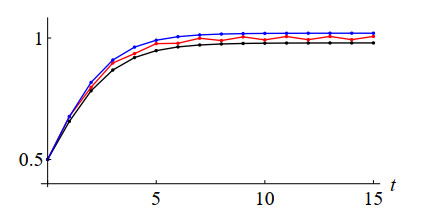









 DownLoad:
DownLoad:
